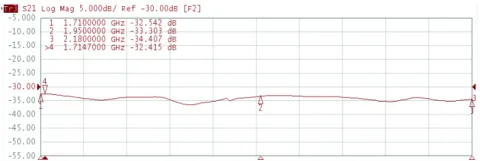The following article serves to build an understanding about the antenna parameter known as Cross-Polar Isolation. Cross polar isolation is a metric specific to orthogonally polarised antennas, and while similar, is not the same as the more generic Inter-Port Isolation. Likewise, cross-polar isolation is similar but not equivalent to Cross-Polar Discrimination (XPD).
Cross-polar isolation strictly refers to the amount of power coupled between two orthogonally polarised ports of a dual-polarised antenna. Inter-port isolation refers instead to the amount of power coupled between any two ports of a multiport antenna regardless of polarisation - for example, an upper-band port and a lower-band port of the same polarisation.
Cross-polar discrimination (XPD) on the other hand is a measure of how polar an antenna element is and instead used measure the rejection of an orthogonally polarised transmission.
Definition of Cross-Polar Isolation
The ratio of the power coupled between the two orthogonally polarised ports of a dual-polarised antenna.
Specification Definition
Disclosing this parameter is important as coupling between antenna ports can influence the level of filtering required for a given base station configuration. When disclosing cross-polar isolation on test reports and datasheets, Powertec follow the BASTA reporting recommendations. BASTA define the reporting of cross polar isolation per the following specification.
- An absolute parameter.
- Specified as a minimum value in dB.
- Tolerance not applicable since defined as an absolute value.
- This parameter is to be defined for the nominal subbands in a broadband antenna. Unless otherwise noted it will be assumed the specification is for the full electrical downtilt range, and for all the ports associated with each frequency subband of the antenna.
- For antennas with multiple dual-polar columns, the specification applies to each column individually and does not address coupling between columns. It is the minimum value for all the dual-polar columns in the base station antenna.
- Coupling between individual ports is best described in terms of “S parameters.” For example, the magnitude in dB of the coupling from port 1 to port 2 is signified by S12.
- For passive devices, such as antennas, coupling is reciprocal, i.e., S12 = S21.
Testing & Reporting
Testing for cross polar isolation is performed using a two port vector network analyser (VNA), or similar.
An example measurement between two antenna ports is shown.

References
NGMN, "Recommendations on Base Station Antenna Standards", NGMN Alliance, N-P-BASTA v11.1, Mar. 2019.